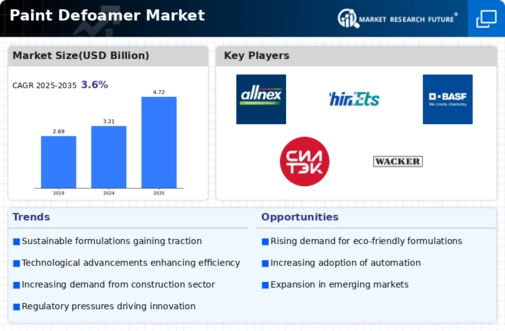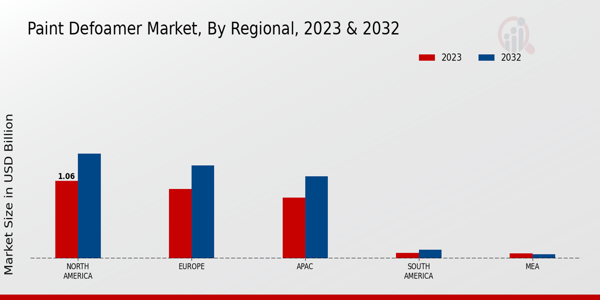Market Growth Projections
The Global Paint Defoamer Market Industry is projected to exhibit robust growth over the coming years. With an estimated market value of 3.21 USD Billion in 2024, the industry is expected to reach 4.72 USD Billion by 2035. This growth trajectory indicates a compound annual growth rate (CAGR) of 3.58% from 2025 to 2035. Such projections underscore the increasing demand for effective defoaming solutions across various applications, including paints, coatings, and adhesives. The anticipated growth reflects not only the rising consumption of paint products but also the ongoing innovations in defoamer technologies that enhance performance and sustainability.
Rising Demand for Eco-Friendly Products
The Global Paint Defoamer Market Industry is experiencing a notable shift towards eco-friendly and sustainable products. As consumers become increasingly aware of environmental issues, manufacturers are compelled to develop defoamers that minimize ecological impact. This trend is reflected in the growing preference for water-based formulations, which typically require effective defoaming agents to maintain product quality. The demand for such sustainable solutions is projected to drive the market, contributing to its growth from an estimated value of 3.21 USD Billion in 2024 to 4.72 USD Billion by 2035, indicating a significant opportunity for innovation in the sector.
Regulatory Compliance and Quality Standards
Regulatory compliance and adherence to quality standards are pivotal in the Global Paint Defoamer Market Industry. Governments and regulatory bodies impose stringent guidelines on chemical formulations, necessitating manufacturers to ensure their products meet safety and environmental criteria. This compliance not only enhances product credibility but also drives innovation in defoamer formulations to align with these regulations. Companies that proactively adapt to these standards are likely to gain a competitive edge, fostering market growth. As the industry evolves, the emphasis on compliance is expected to shape product development and influence market dynamics significantly.
Technological Advancements in Manufacturing
Technological advancements play a crucial role in shaping the Global Paint Defoamer Market Industry. Innovations in production processes and formulations enhance the efficiency and effectiveness of defoamers. For instance, the development of new surfactants and polymer-based defoamers has improved performance, leading to reduced surface tension and enhanced stability. These advancements not only optimize manufacturing processes but also cater to the evolving demands of various applications, including industrial coatings and decorative paints. As a result, the market is poised for growth, with a projected CAGR of 3.58% from 2025 to 2035, reflecting the industry's adaptability to technological changes.
Growth in Construction and Automotive Industries
The Global Paint Defoamer Market Industry is significantly influenced by the expansion of the construction and automotive sectors. As these industries grow, the demand for high-quality paints and coatings increases, necessitating effective defoaming agents to ensure optimal application and finish. For example, the construction of new residential and commercial buildings often requires specialized coatings that incorporate defoamers to prevent defects. Similarly, the automotive sector's focus on aesthetic appeal and durability drives the need for advanced paint formulations. This synergy between industry growth and defoamer demand is expected to bolster market expansion, contributing to the overall market value increase.
Market Diversification and Application Expansion
The Global Paint Defoamer Market Industry is characterized by diversification and expansion into various applications. Defoamers are not limited to traditional paint formulations; they are increasingly utilized in coatings for textiles, adhesives, and sealants. This broadening of application areas presents new opportunities for market players to innovate and cater to diverse customer needs. For instance, the integration of defoamers in industrial coatings enhances performance and durability, appealing to manufacturers across sectors. As the market diversifies, it is likely to witness increased competition and innovation, further driving growth and enhancing product offerings.







